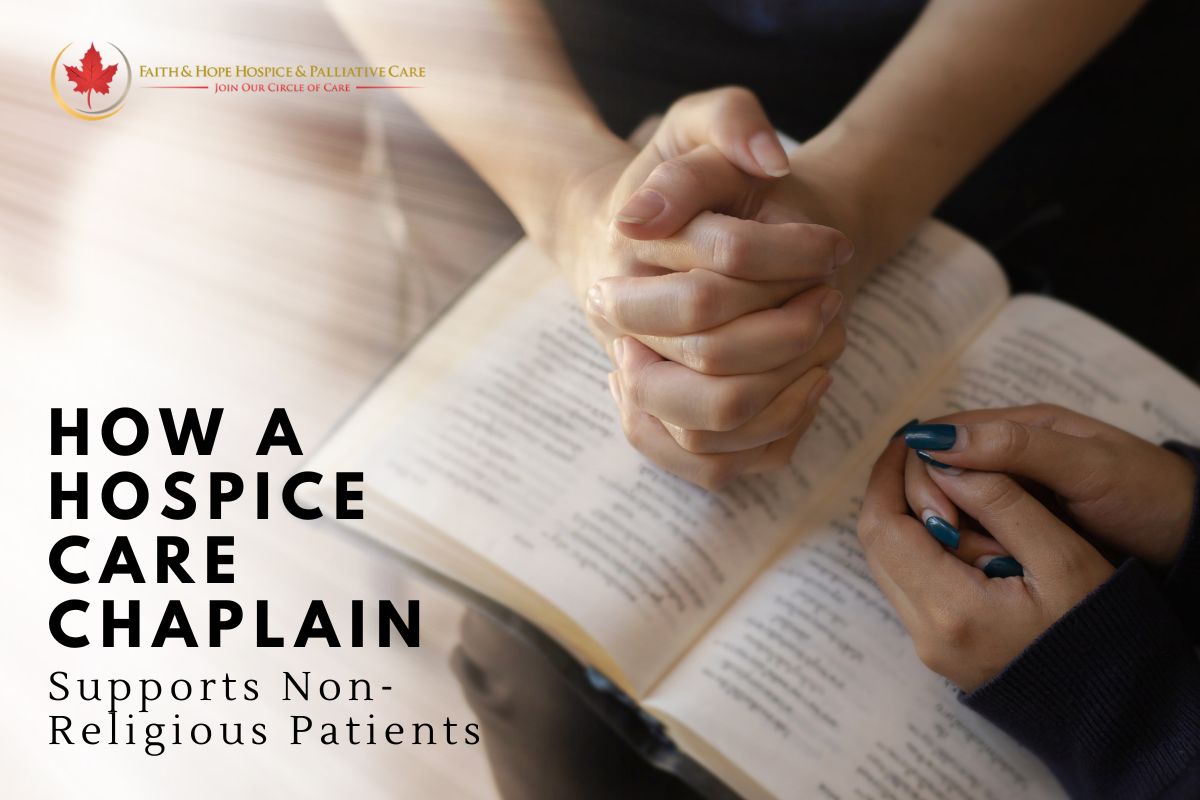
In hospice care, chaplains play a crucial role in supporting patients and their families as they navigate the end-of-life journey. While traditionally associated with religious guidance, hospice chaplains are adept at addressing the spiritual needs of individuals from various backgrounds, including those who identify as non-religious. This article explores the ways in which a Los Angeles hospice care chaplain can provide invaluable support and foster spiritual comfort for non-religious patients during their end-of-life experience.

To effectively support non-religious patients, hospice chaplains recognize that spirituality transcends religious belief. They acknowledge the innate human desire for meaning, purpose, and connection, regardless of religious affiliations. By embracing a broad definition of spirituality, chaplains create an inclusive space that respects and honors the diverse perspectives and beliefs of their patients.
One of the primary roles of a hospice chaplain is to lend a compassionate ear to patients. For non-religious individuals, this involves providing a safe environment for open dialogue. Chaplains actively listen to patients’ concerns, thoughts, and fears, without imposing any religious or spiritual beliefs. By acknowledging and validating their experiences, chaplains help non-religious patients explore their own values and find solace in their unique perspectives.
A crucial aspect of a chaplain’s support for non-religious patients lies in facilitating a life review process. Regardless of religious beliefs, individuals often find comfort in reflecting on their life’s journey, accomplishments, and relationships. Hospice chaplains encourage patients to share their stories and memories, emphasizing the significance of their legacy. Through compassionate engagement, chaplains help non-religious patients find meaning and purpose in their experiences, leaving behind a meaningful impact on the world.
End-of-life experiences at hospice care in Los Angeles often evoke existential questions about life, death, and the nature of existence. Hospice chaplains can engage non-religious patients in thought-provoking discussions that explore these profound questions. They encourage patients to explore their personal philosophies, ethics, and values, helping them find their own answers and fostering a sense of peace and acceptance.
Non-religious patients face emotional and psychological challenges during their end-of-life journey, much like their religious counterparts. Hospice chaplains provide a supportive presence, offering guidance and coping strategies to address grief, anxiety, and fear. Drawing upon their expertise in emotional and psychological care, chaplains empower patients to navigate these difficult emotions and find comfort in their own inner strength.
While traditional religious rituals may not align with the beliefs of non-religious patients, chaplains can help create meaningful and personalized rituals and ceremonies. These rituals may focus on celebrating the patient’s life, acknowledging significant relationships, or embracing nature and the beauty of the world. By tailoring these experiences to the individual’s preferences and values, hospice chaplains facilitate a sense of closure, connection, and peace.
A skilled and compassionate hospice chaplain can offer valuable support to non-religious patients. By recognizing and respecting the broad spectrum of spirituality, fostering open dialogue, and addressing existential questions, chaplains help individuals find solace, meaning, and comfort in their unique perspectives. Through active listening, emotional support, and customized rituals, chaplains create a space where non-religious patients can embrace their end-of-life journey with dignity, peace, and a sense of fulfillment.
If you know someone needing Los Angeles hospice care, contact us at (877) 797-1977 or email [email protected].
Faith and Hope Hospice
We firmly believe that the internet should be available and accessible to anyone, and are committed to providing a website that is accessible to the widest possible audience, regardless of circumstance and ability.
To fulfill this, we aim to adhere as strictly as possible to the World Wide Web Consortium’s (W3C) Web Content Accessibility Guidelines 2.1 (WCAG 2.1) at the AA level. These guidelines explain how to make web content accessible to people with a wide array of disabilities. Complying with those guidelines helps us ensure that the website is accessible to all people: blind people, people with motor impairments, visual impairment, cognitive disabilities, and more.
This website utilizes various technologies that are meant to make it as accessible as possible at all times. We utilize an accessibility interface that allows persons with specific disabilities to adjust the website’s UI (user interface) and design it to their personal needs.
Additionally, the website utilizes an AI-based application that runs in the background and optimizes its accessibility level constantly. This application remediates the website’s HTML, adapts Its functionality and behavior for screen-readers used by the blind users, and for keyboard functions used by individuals with motor impairments.
If you’ve found a malfunction or have ideas for improvement, we’ll be happy to hear from you. You can reach out to the website’s operators by using the following email
Our website implements the ARIA attributes (Accessible Rich Internet Applications) technique, alongside various different behavioral changes, to ensure blind users visiting with screen-readers are able to read, comprehend, and enjoy the website’s functions. As soon as a user with a screen-reader enters your site, they immediately receive a prompt to enter the Screen-Reader Profile so they can browse and operate your site effectively. Here’s how our website covers some of the most important screen-reader requirements, alongside console screenshots of code examples:
Screen-reader optimization: we run a background process that learns the website’s components from top to bottom, to ensure ongoing compliance even when updating the website. In this process, we provide screen-readers with meaningful data using the ARIA set of attributes. For example, we provide accurate form labels; descriptions for actionable icons (social media icons, search icons, cart icons, etc.); validation guidance for form inputs; element roles such as buttons, menus, modal dialogues (popups), and others. Additionally, the background process scans all the website’s images and provides an accurate and meaningful image-object-recognition-based description as an ALT (alternate text) tag for images that are not described. It will also extract texts that are embedded within the image, using an OCR (optical character recognition) technology. To turn on screen-reader adjustments at any time, users need only to press the Alt+1 keyboard combination. Screen-reader users also get automatic announcements to turn the Screen-reader mode on as soon as they enter the website.
These adjustments are compatible with all popular screen readers, including JAWS and NVDA.
Keyboard navigation optimization: The background process also adjusts the website’s HTML, and adds various behaviors using JavaScript code to make the website operable by the keyboard. This includes the ability to navigate the website using the Tab and Shift+Tab keys, operate dropdowns with the arrow keys, close them with Esc, trigger buttons and links using the Enter key, navigate between radio and checkbox elements using the arrow keys, and fill them in with the Spacebar or Enter key.Additionally, keyboard users will find quick-navigation and content-skip menus, available at any time by clicking Alt+1, or as the first elements of the site while navigating with the keyboard. The background process also handles triggered popups by moving the keyboard focus towards them as soon as they appear, and not allow the focus drift outside it.
Users can also use shortcuts such as “M” (menus), “H” (headings), “F” (forms), “B” (buttons), and “G” (graphics) to jump to specific elements.
We aim to support the widest array of browsers and assistive technologies as possible, so our users can choose the best fitting tools for them, with as few limitations as possible. Therefore, we have worked very hard to be able to support all major systems that comprise over 95% of the user market share including Google Chrome, Mozilla Firefox, Apple Safari, Opera and Microsoft Edge, JAWS and NVDA (screen readers).
Despite our very best efforts to allow anybody to adjust the website to their needs. There may still be pages or sections that are not fully accessible, are in the process of becoming accessible, or are lacking an adequate technological solution to make them accessible. Still, we are continually improving our accessibility, adding, updating and improving its options and features, and developing and adopting new technologies. All this is meant to reach the optimal level of accessibility, following technological advancements. For any assistance, please reach out to
